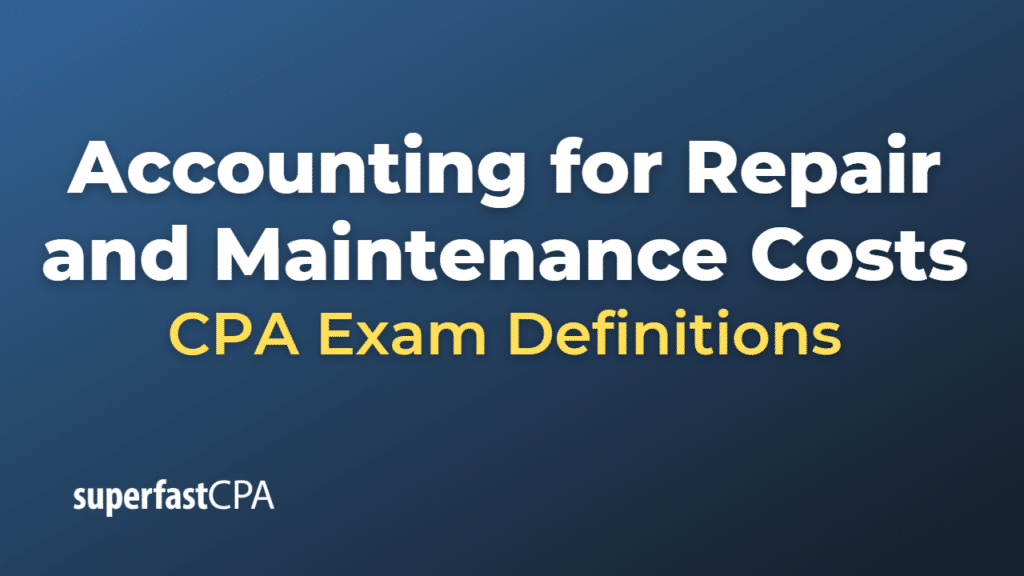Accounting for Repair and Maintenance Costs
Accounting for repair and maintenance costs involves the identification, recognition, measurement, and disclosure of expenses incurred by a company to keep its tangible assets, such as buildings, machinery, equipment, and vehicles, in good operating condition. These costs are typically considered as operating expenses and are necessary to maintain the functionality, efficiency, and safety of the assets without extending their useful lives or increasing their capacities.
Under U.S. Generally Accepted Accounting Principles (GAAP), accounting for repair and maintenance costs is primarily governed by the Financial Accounting Standards Board (FASB) Accounting Standards Codification (ASC) Topic 360, “Property, Plant, and Equipment.”
Here are the key aspects of accounting for repair and maintenance costs:
- Identification: Determine whether a cost qualifies as a repair and maintenance expense. These costs typically include routine maintenance, minor repairs, replacement of parts, and inspection fees.
- Recognition: Repair and maintenance costs should be recognized as expenses in the income statement when they are incurred. This is in accordance with the accrual basis of accounting and the matching principle, which requires that expenses be recognized in the same period as the revenues they help generate.
- Measurement: Repair and maintenance costs should be recorded at their actual amounts, which include the costs of materials, labor, and any related overheads.
- Capitalization vs. expensing: It’s essential to distinguish between repair and maintenance costs and capital expenditures. Capital expenditures are costs incurred to acquire, construct, or improve an asset, which result in extending the asset’s useful life or increasing its capacity. Capital expenditures should be capitalized and added to the carrying amount of the asset, while repair and maintenance costs should be expensed as incurred.
- Disclosure: Although specific disclosure requirements for repair and maintenance costs may not be required, companies should provide clear and concise information about their accounting policies for such costs in the notes to the financial statements.
By properly accounting for repair and maintenance costs, a company provides users of its financial statements with an accurate representation of its financial position and performance, considering the expenses necessary to maintain the functionality and efficiency of its tangible assets.
Example of Accounting for Repair and Maintenance Costs
Let’s consider an example of a company accounting for repair and maintenance costs.
Example: Company XYZ operates a fleet of delivery trucks. During the year, the company incurs the following costs related to the trucks:
- Routine maintenance and oil changes: $10,000
- Replacement of worn-out tires: $5,000
- Repair of a damaged truck door: $2,000
- Installation of a new, more efficient engine in one of the trucks: $20,000
Here’s how Company XYZ would account for these costs:
Step 1:
Identification: Costs 1-3 are repair and maintenance costs, as they are necessary to keep the trucks in good operating condition without extending their useful lives or increasing their capacities. Cost 4 is a capital expenditure, as it improves the truck’s efficiency and extends its useful life.
Step 2:
Recognition and measurement: Company XYZ recognizes repair and maintenance costs as expenses in the income statement when they are incurred.
| Repair and maintenance expense: | |
| Routine maintenance and oil changes: | $10,000 |
| Replacement of worn-out tires: | $5,000 |
| Repair of a damaged truck door: | $2,000 |
| Total repair and maintenance expense: | $17,000 |
Company XYZ capitalizes the cost of the new engine as an improvement to the truck.
| Capital expenditure (improvement): |
| Installation of a new, more efficient engine: $20,000 |
Step 3:
Financial statement impact:
- The repair and maintenance expense of $17,000 is recognized in the income statement, which reduces the company’s net income.
- The capital expenditure of $20,000 is added to the carrying amount of the truck in the balance sheet, increasing the company’s property, plant, and equipment.
Step 4:
Disclosure: Company XYZ provides information about its accounting policies for repair and maintenance costs and capital expenditures in the notes to the financial statements.
By properly accounting for repair and maintenance costs and capital expenditures, Company XYZ provides users of its financial statements with an accurate representation of its financial position and performance, considering the expenses necessary to maintain the functionality and efficiency of its tangible assets, and the costs incurred to improve or extend the useful lives of those assets.













